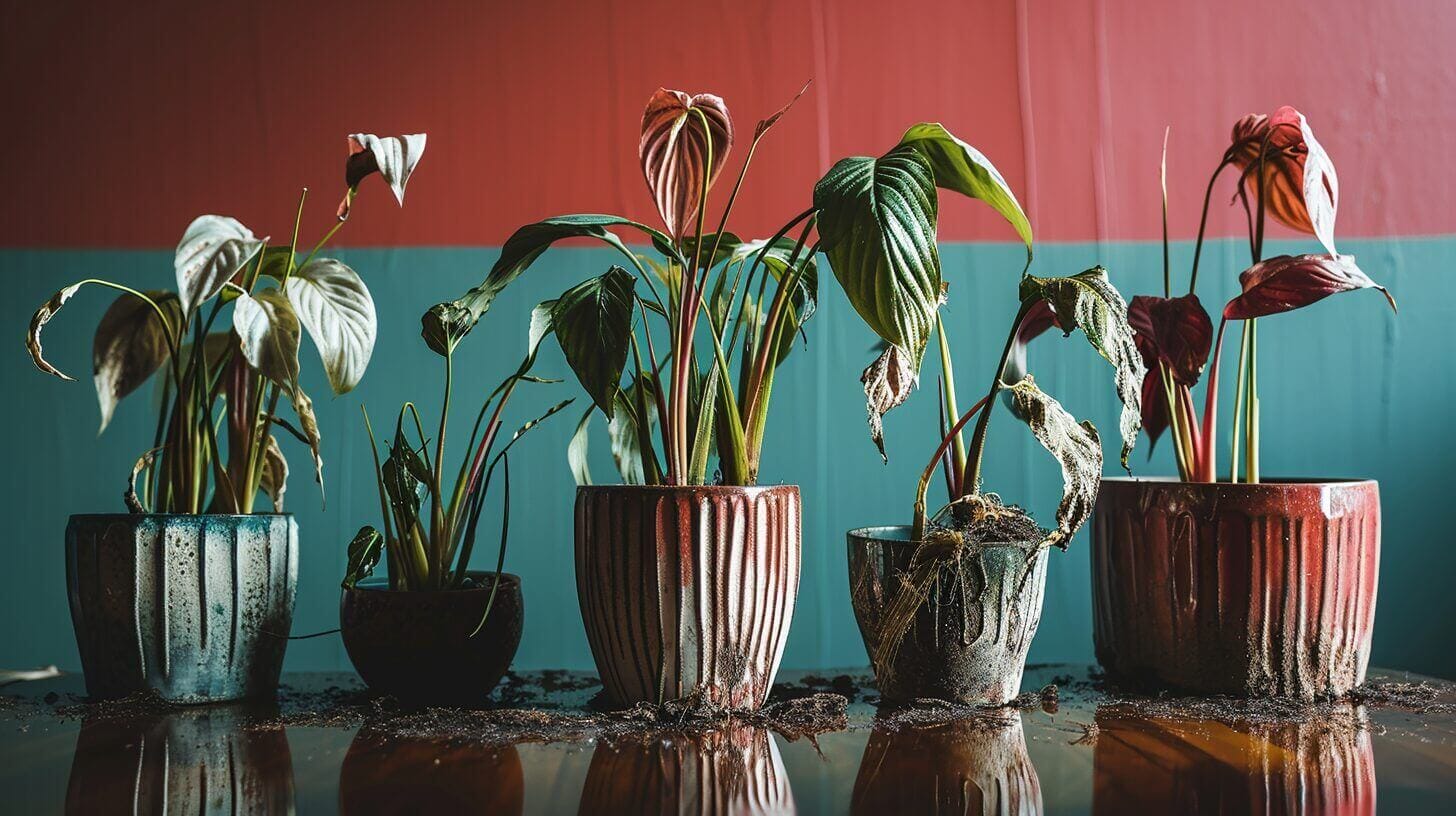How to Save a Peace Lily Root Rot: Symptoms, Causes & Treatment For Root Rot In Peace Lily Plant
In the world of indoor gardening, peace lilies stand as elegant symbols of tranquility and beauty. However, even these resilient plants are not immune to the menace of root rot. This insidious condition can cause irreversible damage if left untreated.
In this article, we will explore the symptoms, causes, and effective treatment options for root rot in peace lilies. By understanding the signs and taking proactive measures, you can ensure the longevity and vitality of your beloved peace lilies, fostering an environment of serenity and growth.
Key Takeaways
- Wilting and yellowing of leaves are symptoms of root rot in peace lilies.
- Continuous exposure of roots to excessive moisture, overwatering, and poorly drained soil are common causes of root rot in peace lilies.
- Proper watering practices, allowing soil to dry out slightly between waterings, using well-draining soil, and regularly inspecting roots are essential for preventing root rot in peace lilies.
- Treatment options for root rot in peace lilies include natural remedies like removing affected plants, washing roots, and replanting in fresh soil, as well as using diluted hydrogen peroxide or chemical treatments like fungicides in severe cases.
Recognizing the Symptoms of Peace Lily Has Root Rot
The wilting and yellowing of leaves are key symptoms to look out for when recognizing root rot in peace lilies. Root rot is a common problem that occurs when the roots of a plant are continuously exposed to excessive moisture. It is often caused by overwatering or using poorly drained soil. As the roots become waterlogged, they begin to decay, leading to a lack of oxygen and nutrient uptake. This results in the wilting and yellowing of leaves, as the plant is unable to properly absorb water and nutrients.
Preventing root rot in peace lilies starts with proper watering practices. It is important to allow the soil to dry out slightly between waterings, as overwatering can suffocate the roots. Additionally, using well-draining soil that allows excess water to escape is crucial. Avoiding common mistakes such as using pots without drainage holes or allowing water to sit in the saucer can help prevent root rot.
Regularly inspecting the roots and repotting the plant when necessary is also important. If you notice any signs of root rot, such as a foul odor or slimy, mushy roots, it is essential to act quickly. Trim away any affected roots and repot the plant in fresh, well-drained soil.
Understanding the Causes of Peace Lily root
During our current discussion on understanding the causes of root rot in peace lilies, we have identified overwatering and poorly drained soil as the primary factors contributing to this common problem.
Root rot occurs when the roots of a plant become waterlogged, leading to decay and the inability of the roots to absorb nutrients properly.
To prevent root rot in peace lilies, it is important to take the following measures:
- Proper watering: Peace lilies prefer moist soil but not soggy conditions. Allow the top inch of soil to dry out before watering again. Avoid overwatering, as this can lead to root rot.
- Well-drained soil: Ensure that the potting soil used for peace lilies is well-drained. This allows excess water to flow out and prevents water from accumulating around the roots.
Signs of root rot in peace lilies include wilting leaves, yellowing or browning of leaves, and a foul odor coming from the soil. If you notice these signs, it is crucial to take immediate action to save your plant. Remove the affected parts, repot the plant in fresh, well-drained soil, and adjust your watering practices accordingly.
Steps to Prevent Root Rot in Peace Lilies
In our discussion on preventing root rot in peace lilies, implementing proper watering techniques and using well-drained soil are essential steps to maintain the health and vitality of these plants. Peace lilies are susceptible to root rot due to their preference for moist soil. However, overwatering can lead to excessive moisture accumulation, creating the perfect environment for root rot to develop.
To prevent overwatering, it is crucial to allow the top inch of soil to dry out before watering again. This can be determined by sticking your finger into the soil and checking for moisture. Additionally, using well-draining soil can help prevent water from pooling around the roots, reducing the risk of root rot. Well-draining soil can be achieved by adding organic matter such as peat moss or perlite to the potting mix.
By incorporating these preventive measures, peace lilies can thrive in a healthy environment, free from the dangers of root rot.
Transitioning into the subsequent section about effective treatment options for root rot in peace lilies, it is important to note that even with the best prevention methods, root rot can still occur. Therefore, it is crucial to be aware of the symptoms and have a plan in place to address the issue promptly.
Effective Treatment Options for Root Rot in Peace Lilies
How can root rot in peace lilies be effectively treated?
Root rot is a common problem that affects peace lilies, causing the roots to decay and ultimately leading to plant death if left untreated.
To effectively treat root rot in peace lilies, there are several options available, including:
- Natural remedies: Using natural remedies can help combat root rot in peace lilies. One effective method is to remove the affected plant from its pot, gently wash the roots under running water to remove any infected soil, and then replant it in fresh, well-draining soil. Another natural remedy is to apply a solution of diluted hydrogen peroxide to the affected roots, as it can help kill off the harmful bacteria causing the root rot.
- Chemical treatments: In severe cases of root rot, chemical treatments may be necessary. Fungicides containing active ingredients like thiophanate-methyl or fosetyl-aluminum can be used to control the spread of the disease. It is important to carefully follow the instructions provided by the manufacturer when using chemical treatments, as they can be harmful if not used correctly.
- Preventive measures: Taking preventive measures can also help in treating root rot. It is important to ensure that the peace lily is planted in well-draining soil and that the pot has proper drainage holes. Overwatering should be avoided, as it can create the perfect conditions for root rot to develop.
Tips for Maintaining Healthy Peace Lilies and Preventing Root Rot
What are some effective strategies for ensuring the health of peace lilies and preventing the occurrence of root rot? Peace lilies are beautiful and popular indoor plants known for their lush green foliage and elegant white flowers. However, they are susceptible to root rot, a condition caused by overwatering and poor drainage.
To maintain healthy peace lilies and prevent root rot, here are some effective strategies to consider.
First, watering is crucial. It is essential to water peace lilies thoroughly but allow the soil to dry out slightly between waterings. Overwatering can lead to root rot, so it is important to strike a balance. Additionally, using well-draining soil and pots with drainage holes can help prevent excess moisture from accumulating in the roots.
Second, proper lighting is key. Peace lilies thrive in bright, indirect light, but direct sunlight can scorch their leaves. Placing them near a window with filtered light or providing them with artificial light can ensure their overall health and prevent stress on the plant.
Lastly, maintaining good hygiene is essential. It is important to remove dead or yellowing leaves promptly and keep the plant clean by wiping the leaves with a damp cloth to prevent the growth of fungal diseases.
Frequently Asked Questions
Can Root Rot Prevent a Peace Lily from Blooming Indoors?
Root rot can indeed prevent a peace lily from blooming indoors. To avoid this, follow these peace lily blooming tips: Ensure proper drainage by using well-draining soil and pots with drainage holes. Avoid overwatering and allow the soil to dry out slightly between watering sessions. Provide sufficient light, but avoid placing the plant in direct sunlight. Regularly inspect the roots for any signs of rot and promptly treat any issues that arise.
Can Repotting a Peace Lily Help Save It from Root Rot?
Repotting is crucial for preventing and treating root rot in a peace lily. By following a step-by-step peace lily propagation guide, you can ensure a successful repotting process. This helps to refresh the plant‘s soil, remove any infected or decaying roots, and provide better drainage. Repotting can revive a peace lily and contribute to its overall health and longevity.
How Often Should I Water My Peace Lily to Prevent Root Rot?
Proper watering is crucial for preventing root rot in peace lilies. Overwatering is the main cause of this condition, so it is important to understand how often to water your plant.
Can I Use Tap Water to Water My Peace Lily?
Using tap water to water a peace lily has its pros and cons.
Tap water contains minerals that can accumulate in the soil over time and cause root rot. However, tap water is readily available and convenient.
To avoid potential harm, it is recommended to use filtered or distilled water, or to let tap water sit for 24 hours to allow chlorine to dissipate.
Alternatively, rainwater or filtered water from a dehumidifier can be used as alternatives for peace lily watering.
Can I Use Fertilizer to Promote Healthy Growth in My Peace Lily?
Using fertilizer can be beneficial for promoting healthy growth in a peace lily. Fertilizers provide essential nutrients that the plant needs to thrive, such as nitrogen, phosphorus, and potassium.
However, it is important to be cautious when applying fertilizer to prevent overwatering, as this can lead to root rot. It is recommended to follow the instructions on the fertilizer packaging and to only apply it in moderation.
This will help ensure the well-being of your peace lily and prevent any potential risks.
Should I Trim the Affected Roots When Treating Root Rot in My Peace Lily?
When treating root rot in a peace lily, it is important to consider whether trimming the affected roots is necessary. While trimming the roots may seem like a logical solution, it is not always the best course of action.
There are alternative treatments that can be effective in saving the plant without resorting to trimming. These alternative treatments should be explored and considered before deciding to trim the affected roots.
Can I Repot a Peace Lily to Prevent Root Rot?
Repotting a peace lily can be a preventive measure to avoid root rot. By repotting, you can provide fresh, well-draining soil that promotes healthy root growth and prevents waterlogging.
Additionally, repotting allows you to inspect the roots for any signs of rot, such as discoloration or a foul odor. If you notice any of these signs, it is crucial to trim the affected roots before repotting to prevent the spread of rot and ensure the plant’s overall health and vitality.
What is peace lily root rot?
Peace lily root rot is a condition caused by overwatering the plant, leading to the growth of fungus in the root system. This can cause the roots to decay and can be fatal for the plant if not treated promptly.
What are the signs of root rot in a peace lily?
Signs of root rot in a peace lily include yellowing leaves, wilting, and a foul smell coming from the soil. If you examine the roots, they may appear brown or black and feel mushy.
How can I treat peace lily root rot?
To treat peace lily root rot, you need to remove the plant from its pot, trim away the damaged roots, and repot your peace lily in fresh soil. Make sure to water the plant properly to avoid overwatering.
What causes root rot in peace lilies?
Root rot in peace lilies is usually caused by overwatering. This creates a damp environment where fungus can thrive and damage the plant’s roots.
How can I prevent my peace lily from getting root rot?
To prevent your peace lily from getting root rot, ensure that you’re not overwatering the plant. The soil should be kept moist but not waterlogged. Also, make sure that your pot has good drainage.
How can I recover a peace lily from root rot?
To recover a peace lily from root rot, you need to repot your peace lily in fresh soil after removing all the rotted roots. Then, water the plant properly and place it in a location with indirect sunlight.
Is an overwatered peace lily susceptible to root rot?
Yes, an overwatered peace lily is susceptible to root rot. Overwatering creates a damp environment that encourages the growth of fungus which can cause root rot.
How can I get rid of root rot in my peace lily plant?
To get rid of root rot in your peace lily plant, you need to remove all the rotted roots and repot your peace lily in fresh soil. Make sure to water the plant properly to avoid overwatering in the future.
Can Root Rot in Peace Lilies Affect Dogs if Ingested?
Can root rot in peace lilies affect dogs if ingested? Many pet owners wonder, “Is peace lilies poisonous to dogs?” Unfortunately, yes. If your dog ingests any part of a peace lily, it can lead to severe toxicity. It is crucial to keep peace lilies out of reach and promptly seek veterinary assistance if your dog shows signs of poisoning.
Can repotting help a peace lily with root rot?
Yes, repotting can help a peace lily with root rot. By removing all the rotted roots and repotting in fresh soil, you can give your plant a new lease on life.
Are all parts of a peace lily susceptible to root rot?
Yes, all parts of a peace lily’s root system are susceptible to root rot if the conditions are right. This includes both the main roots and smaller feeder roots.







